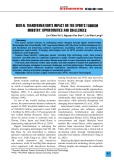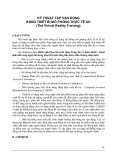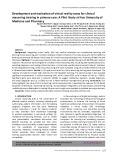Rendering Pipeline: 3-D
Các giải thuật sinh các thực thể cơ sở
Transform
Illuminate
Transform
Clip
Project
Rasterize
Le Tan Hung hunglt@it-hut.edu.vn 0913030731
Rendering Pipeline Rendering Pipeline
Framebuffer Framebuffer
Display Display
Model & Camera Model & Camera Parameters Parameters
The Rendering Pipeline: 3-D
Phép biến đổi Transformations
(cid:122) screen space- không gian màn hình (cid:122) model space Không gian mô hình
Các điểm của hệ thống tọa độ 3D thế giới thực •• Các điểm của hệ thống tọa độ 3D thế giới thực
(a.k.a. object space or world space)
Scene graph Object geometry
Các điểm bóng theo mô hình chiếu sáng •• Các điểm bóng theo mô hình chiếu sáng
Modeling Transforms
Các điểm trong mô hình hệ tọa độ Camera hay tọa độ điểm nhìn •• Các điểm trong mô hình hệ tọa độ Camera hay tọa độ điểm nhìn
Lighting Calculations
(cid:122) 3 loại phép biến đổi: – Modeling transforms – Viewing transforms – Projection transforms
Các tọa độ điểm của vùng hình chóp cụt với điểm nhìn xác định •• Các tọa độ điểm của vùng hình chóp cụt với điểm nhìn xác định
Viewing Transform
•• ĐĐiểm 2
theo tọa độ màn hình sau phép chiếu được xén tỉa iểm 2--DD theo tọa độ màn hình sau phép chiếu được xén tỉa
Clipping
Projection Transform
Rendering: Transformations
Rendering: Transformations
(cid:122) Modeling transforms
(cid:122) Viewing transform
model w.r.t. each other
the camera
– Size, place, scale, and rotate objects parts of the – Rotate & translate the world to lie directly in front of
(cid:122) Typically place camera at origin (cid:122) Typically looking down -Z axis
– Object coordinates (cid:198) world coordinates
– World coordinates (cid:198) view coordinates
Y
Y
Z
X
X
Z
1
Rendering: Transformations
Rendering: Transformations
(cid:122) Projection transform
(cid:122) All these transformations involve shifting
(cid:122) Distant = small: the pinhole camera model – View coordinates (cid:198) screen coordinates
coordinate systems (i.e., basis sets) (cid:122) Oh yeah, that’s what matrices do… (cid:122) Represent coordinates as vectors, transforms
as matrices
−
θ θ
– Apply perspective foreshortening
sin cos
⎤ ⎥ ⎦
⎡ X ⎢ Y ⎣
θ ⎤ ⎥ θ ⎦
⎡ cos ⎢ sin ⎣
′ ⎤ =⎥ ′ ⎦
⎡ X ⎢ Y ⎣
(cid:122) Multiply matrices = concatenate transforms!
Rendering: Transformations
The Rendering Pipeline: 3-D
(cid:122) Homogeneous coordinates: represent
Result: Result:
•• All vertices of scene in shared 3
D “world” coordinate system All vertices of scene in shared 3--D “world” coordinate system
Scene graph Object geometry
coordinates in 3 dimensions with a 4-vector – Denoted [x, y, z, w]T
Vertices shaded according to lighting model •• Vertices shaded according to lighting model
Modeling Transforms
(cid:122) Note that w = 1 in model coordinates – To get 3-D coordinates, divide by w:
[x’, y’, z’]T = [x/w, y/w, z/w]T
•• Scene vertices in 3
D “view” or “camera” coordinate system Scene vertices in 3--D “view” or “camera” coordinate system
Lighting Calculations
Exactly those vertices & portions of polygons in view frustum •• Exactly those vertices & portions of polygons in view frustum
Viewing Transform
(cid:122) Transformations are 4x4 matrices (cid:122) Why? To handle translation and projection
D screen coordinates of clipped vertices •• 22--D screen coordinates of clipped vertices
Clipping
Projection Transform
Rendering: Ánh sáng - Lighting
The Rendering Pipeline: 3-D
(cid:122) Illuminating a scene: coloring pixels according to
Result: Result:
some approximation of lighting – Global illumination: solves for lighting of the whole
Scene graph Object geometry
•• All vertices of scene in shared 3 system system
scene at once
D “world” coordinate All vertices of scene in shared 3--D “world” coordinate Modeling Transforms
lighting each polygon separately
(cid:122) Interactive graphics (e.g., hardware) does only
local illumination at run time
– Local illumination: local approximation, typically Lighting Calculations Vertices shaded according to lighting model •• Vertices shaded according to lighting model D “view” or “camera” coordinate Scene vertices in 3--D “view” or “camera” coordinate Viewing Transform •• Scene vertices in 3 system system Clipping •• Exactly those vertices & portions of polygons in view Exactly those vertices & portions of polygons in view frustum frustum D screen coordinates of clipped vertices •• 22--D screen coordinates of clipped vertices Projection Transform
2
Rendering: Clipping
Rendering: Xén tỉa - Clipping
(cid:122) Clipping a 3-D primitive returns its intersection
(cid:122) Clipping is tricky!
with the view frustum:
– We will have a whole assignment on clipping
In: 3 vertices In: 3 vertices Out: 6 vertices Out: 6 vertices
Clip
In: 1 polygon In: 1 polygon Out: 2 polygons Out: 2 polygons
Clip
The Rendering Pipeline: 3-D
Modeling: The Basics
Transform
(cid:122) Common interactive 3-D primitives: points,
Illuminate
lines, polygons (i.e., triangles)
Transform
(cid:122) Organized into objects
Clip
Project
– Collection of primitives, other objects – Associated matrix for transformations
Rasterize
(cid:122) Instancing: using same geometry for multiple
objects – 4 wheels on a car, 2 arms on a robot
Rendering Pipeline Rendering Pipeline
Framebuffer Framebuffer
Display Display
Model & Camera Model & Camera Parameters Parameters
Modeling: The Scene Graph
Modeling: The Scene Graph
(cid:122) Traverse the scene graph in depth-first order,
concatenating transformations
(cid:122) Đồ thị cảnh scene graph : cây đồ thị lưu trữ đối tượng, quan hệ giũa các đối tượng và các phép biến đổi trên đối tượng đó
(cid:122) Maintain a matrix stack of transformations
Robot
Head
Body
(cid:122) Nút là đối tượng; (cid:122) Cành là các thực thể biến đổi – Tương ứng là các ma trận
Robot
Visited Visited
Leg
Mouth
Eye
Trunk
Arm
Head
Body
Unvisited Unvisited
Foot
Mouth
Eye
Leg
Trunk
Arm
Matrix Matrix Stack Stack Active Active
3
Modeling: The Camera
Modeling: The Camera
(cid:122) Finally: need a model of the virtual camera
(cid:122) Camera parameters (FOV, etc) are encapsulated
(cid:122) Field of view, depth of field, distortion, chromatic aberration…
– Can be very sophisticated
in a projection matrix – Homogeneous coordinates (cid:198) 4x4 matrix! – See OpenGL Appendix F for the matrix
(cid:122) Camera pose: position & orientation
(cid:122) The projection matrix premultiplies the viewing
– Captured in viewing transform (i.e., modelview matrix)
matrix, which premultiplies the modeling matrices – Actually, OpenGL lumps viewing and modeling
transforms into modelview matrix
(cid:122) Pinhole camera model – Field of view – Aspect ratio – Near & far clipping planes
– Interactive graphics (OpenGL):
Biểu diễn đoạn thẳng
Rời rạc hoá điểm ảnh (Scan Conversion rasterization)
(cid:122) Biểu diễn tường minh (y-y1)/( x-x1) = ( y2-y1)/( x2-x1)1
y = kx + m
–
k = (y2-y1)/( x2-x1)
– m = y1- kx1
–
Δy = k Δx
(cid:122) Là tiến trình sinh các đối tượng hình học cơ sở bằng phương pháp xấp xỉ dựa trên lưới phân giải của màn hình (cid:122) Tính chất các đối tượng cần đảm bảo : P(x2 , y2)
(cid:122) Biểu diễn không tường minh (y2-y1)x - (x2-x1)y + x2y1 - x1y2 = 0
u
–
hay rx + sy + t = 0 s = -(x2-x1 )
–
r = (y2-y1) và t = x2y1 - x1y2
– smooth – continuous – pass through specified points – uniform brightness – efficient
P(x1, y1)
(cid:122) Biểu diễn tham biến P(u) = P1 + u(P2 - P1)
u [0,1]
X = x1 + u( x2 - x1 )
Y = y1 + u( y2 - y1 )
m
Thuật toán DDA (Digital Differential Analizer)
Sinh đường tròn Scan Converting Circles
(cid:122) Explicit: y = f(x)
2
2
y
x
R
= ±
Thuậttoán ddaline (x1, y1, x2, y2)
x1, y1, x2, y2 : tọa độ 2 điểm đầu
Giải thuật thông thường DrawLine(int x1,int y1, int x2,int y2, int color) {
cuối
− Usually, we draw a quarter circle by incrementing x from 0 to R in unit steps and solving for +y for each step.
k : hệ số góc x,y,m :biến
(cid:122) Parametric:
begin
- by stepping the angle from 0 to 90 - avoids large gaps but still insufficient.
cos sin
θ θ
m =(x2-x1)/(y2-y1); x = x1; y = y1;
x R = y R = (cid:122) Implicit: f(x) = x2+y2-R2
k = 1/m; putpixel(x,y);
If f(x,y) = 0 then it is on the circle.
f(x,y) > 0 then it is outside the circle. f(x,y) < 0 then it is inside the circle.
while x float y;
int x;
for (x=x1; x<=x2; x++)
{ y = y1 + (x-x1)*(y2-y1)/(x2-x1)
WritePixel(x, Round(y), color ); putpixel(round(x),round(y)); end; end; }}
Giải thuật DDA
(cid:122) Với 0 < k < 1
xi+1 = xi + 1
yi+1 = yi + k
với i=1,2,3.... IBM d2 = y - yi = k(xi +1) + b - yi
d1 = yi+1 - y = yi + 1 - k(xi + 1) - 2 b d2
d1 yi+1 1 (cid:122) 1960 Bresenham thuộc d1 d2 0 yi (cid:122) điểm gần với đường thẳng
dựa trên độ phân giai hưu
hạn 0 1 2 = -2k(xi + 1) + 2yi - 2b + 1 xi xi+1 (cid:122) loại bỏ được các phép toán
chia và phép toán làm tròn
như ta đã thấy trong gỉai
thuật DDA (cid:122) If d1 ≤ d2 => yi+1 = yi + 1
else d1 > d2 => yi+1 = yi
(cid:122) D = d1 - d2 (cid:122) Xét đoạn thẳng với 0 < k < 1 (cid:122) Pi = ΔxD = Δx (d1 - d2) (cid:122) Jack Bresenham 1965 / Pitteway 1967
(cid:122) VanAken áp dụng cho việc sinh các đường Pi = -2Δyxi + 2Δxyi + c
Pi+1 - Pi thẳng và đường tròn 1985 = -2Δy(xi+1 - xi) + 2Δx(yi+1 - yi) (cid:122) Các công thức đơn giản hơn, tạo được các điểm tương tự như với Bresenham (cid:122) d = F (xi + 1, yi + 1/2) là trung điểm của đoạn (cid:122) Nếu Pi ≤ 0 ⇒ yi+1 = yi + 1
Pi+1 = Pi - 2Δy + 2Δx AB (cid:122) Nếu Pi > 0 ⇒ yi+1 = yi (cid:122) Việc so sánh, hay kiểm tra M sẽ được thay Pi+1 = Pi - 2Δy A
M
B
( xi , yi ) bằng việc xét giá trị d.
– Nếu d > 0 điểm B được chọn, yi+1 = yi
– nếu d < 0 điểm A được chọn. ⇒ yi+1 = yi + P1 = Δx(d1 - d2)
P1 = -2Δy + Δx 1 – Trong trường hợp d = 0 chúng ta có thể chọn điểm bất kỳ hoặc A, hoặc B. (cid:122) If di > 0 then chọn điểm A ⇒ trung điểm tiếp theo sẽ có dạng: ,2 c + + + (cid:122) Sử dụng phương pháp biểu diễn không tường minh on line x
i y
i i 1
+ 3
2 3
2 ⎛
⎜
⎝ ⎞
d
=⇒⎟
⎠ ⎛
yb
⎜
i
⎝ ⎞
+⎟
⎠ c 0
⇒<+ + ba = ++ d
i c 0
⇒>+ + )
yx
,
i
i
)
yx
,
i
i
)i
yx
,
i ax
0=+
by
c
+
by
c
0
+
⇒=+
i
by
i
by
i ax
i
ax
i
ax
i (
(
(
(cid:122) Tại mỗi trung điểm của đoạn thẳng giá trị được tính above line below line d c = + )
1
++ i (
xa
i 1
2 ⎛
yb
⎜
i
⎝ ⎞
+⎟
⎠ (cid:122) Chúng ta gọi di là biến quyết định của bước thứ i (cid:122) if di < 0 then chọn điểm B và trung điểm mới là ,2 d c + + = + )
2
++ x
i y
i i (
xa
i 1
+ 1
2 1
2 (cid:122) Ta có: ⎞
⇒⎟
⎠ ⎛
⎜
⎝ ⎞
+⎟
⎠ ⎛
yb
⎜
i
⎝ d a = + i initialisation a y
=Δ= − y b x =Δ−= − = Cx
+ y
end
x
end y
start
x
start y
Δ
x
Δ xCc
Δ= ⎫
⎪
where
⎬
⎪
⎭ (cid:122) Ðiểm đầu dx = x_end-x_start
dy = y_end-y_start
d = 2*dy-dx
x = x_start
y = y_start
while x < x_end if d <= 0 then choose B d = d+(2*dy)
x = x+1 else x ,1 y d c + + = + (
xa )
1
++ start start start start start 1
2 1
2 ⎛
⎜
⎝ ⎞
⇒⎟
⎠ 0 a ++= by c ⎛
yb
⎜
⎝
+ = + a
++ [
ax ] start start b
2 ⎞
+⎟
⎠
b
2 choose A d = d+2*(dy-dx)
x = x+1
y = y+1 endif
SetPixel(x,y) endwhile (cid:122) Sử dụng phương pháp biểu diễn (cid:122) d = a(xi + 1) + b(yi + 1/2) + c
(cid:122) Nếu điểm được chọn là B thi M sẽ tang 2 2 không tường minh trong giải thuật x y r − + − − 02
= ( ) ( ) x
c y
c (cid:122) Thực hiện giải thuật trên 1/8 theo x một đơn vị
– di +1 = F(xi +2, yi + 1/2) No – di = a(xi + 1) + b(yi + 1/2) + c đường tròn và lấy đối xứng xho
các góc còn lại. (cid:122) Với di là giá trị của đường tròn tại yes một điểm bất kỳ ta có inside
circle yes = d
i (cid:122) Nếu điểm A được chọn thi` M tăng theo
2 hướng x và y với cùng một đơn vị.
di + 1 = F (xi + 2, yi + 3/2)
– = a(xi + 2) + b(yi +3/2) + c
– di + 1 = di + a + b. on
circle
outside
circle (
if 0
(
if 0
(
if 0 )
is
)
is
)
is no yx
,
i
i
yx
,
i
i
yx
,
i
i <
⎧
⎪
=
⎨
⎪
>
⎩ (cid:190) Với a + b = dy - dx. (cid:122) Again, as with the line algorithm, the choice of A or B can be used to determine the new value of di+1 (cid:122) As with the line, we determine the value of the decision variable
by substituting the mid-point of the next pixel into the implicit
form of the circle: 2 2 d r = + + − i x
i y
i variable: 1
2 ⎛
⎜
⎝ 2
⎞
−⎟
⎠ 2 2 ,2 r + + − + − (cid:122) If di < 0 we choose pixel A otherwise we choose pixel B )
2 ( y
i y
i x
i x
i 1
+ 1
2 1
2 – Note: we currently assume the circle is centered at the origin (cid:122) If A chosen then next midpoint has the following decision
2
⎞
−⎟
⎠ ⎞
d
=⇒⎟
i
⎠ ⎛
⎜
⎝ ⎛
⎜
⎝
3 d 2 = + + i x
i (cid:122) Otherwise if B is chosen then the next decision variable is given 2 2 by: ,2 r + + − + − ( )
2 x
i y
i x
i y
i 1
+ 3
2 2
⎞
−⎟
⎠ ⎞
d
=⇒⎟
i
⎠ ⎛
⎜
⎝ ⎛
⎜
⎝
2 3
2
5 2 = + − + d
i x
i y
i (cid:122) If we assume that the radius is an integral value, then the first stop at diagonal ⇒ end of octant initialisation 2 2 r r 1 r
+− − 1
4 1
2 ⎞
−⎟
⎠ ⎞
d
+=⇒⎟
0
⎠ ⎛
⎜
⎝ pixel drawn is (0, r) and the initial value for the decision variable
is given by:
⎛
r
,1
⎜
⎝ r 5
−=
4
(cid:122) Although the initial value is fractional, we note that all other d = 1-r
x = 0
y = r
while y < x if d < 0 then choose A d = d+2*x+3
x = x+1 else d r values are integers.
⇒ we can round down: −=10 Translate to the circle center choose B d = d+2*(x-y)+5
x = x+1
y = y-1 endif
SetPixel(cx+x,cy+y) endwhile 2 2 F x y
( , ) 2
b x 2
a y 2 2
a b 0 = + − = (cid:122) Firstly we divide the quadrant into two regions
(cid:122) Boundary between the two regions is – the point at which the curve has a slope of -1
– the point at which the gradient vector has the i and j components of lies in the first quadrant, the other three quadrants can
be drawn by symmetry grad F x y
( , ) F x
/ F y
/ 2
b x
2 (cid:122) 2a is the length of the major axis along the x axis.
(cid:122) 2b is the length of the minor axis along the y axis.
(cid:122) The midpoint can also be applied to ellipses.
(cid:122) For simplicity, we draw only the arc of the ellipse that equal magnitude 2
a y
2 = ∂ + (cid:122) At the next midpoint, if a2(yp-0.5)<=b2(xp+1), we switch region 1=>2
(cid:122) In region 1, choices are E and SE với một font chư cho trước là một
bitmap chữ nhật nhỏ (cid:122) Trên cơ sỏ định nghĩa mỗi ký tự – Initial condition: dinit = b2+a2(-b+0.25)
– For a move to E, dnew = dold+DeltaE with DeltaE = b2(2xp+3)
– For a move to SE, dnew = dold+DeltaSE with (cid:122) Font/typeface: set of character shapes
(cid:122) fontcache – các ký tự theo chuỗi liên tiếp nhau (cid:122) In region 2, choices are S and SE trong bộ nhớ
(cid:122) Dạng cơ bản DeltaSE = b2(2xp+3)+a2(-2yp+2) – – Initial condition: dinit = b2(xp+0.5)2+a2((y-1)2-b2)
– For a move to S, dnew = dold+Deltas with Deltas = a2(-2yp+3)
– For a move to SE, dnew = dold+DeltaSE with (thường N, nghiêng I, đậm B,
nghiêng đậm B+I) (cid:122) Stop in region 2 when the y value is zero. – Also colour, size, spacing and orientation DeltaSE = b2(2xp+2)+a2(-2yp+3) (cid:122) Thuộc tính (cid:122) Xây dựng theo phương pháp định nghĩa các ký tự
bởi đường cong mềm bao
ngoài của chúng. toán Typedef struct
{
int leftx,
int width;
} Char location; //Vị trí của text (cid:122) Tốn kém nhất về mặt tính (cid:122) Chất lượngcao Typedef struct
{
CacheId;
Heiglit;
CharSpace; // Độ rộng chữ
// Khoảng cách giữa các ký tự Charlocation Table [128]; } fontcache (cid:122) Tồn tại rất nhiều giải thuật sinh đa giác.
(cid:122) Mỗi giải thuật phục vụ cho 1 loại đa giác nhất tự ( copypixel) (cid:122) Phức tạp (Tính toán (cid:122) Đơn giản trông việc sinh ký định:
– some algorithms allow triangular polygons only
– others require that the polygons are convex and non self- scale) đòi hỏi lưu trữ thêm intersecting and have no holes (cid:122) Lưu trữ lớn
(cid:122) Các phép biến đổi (I,B, phương trình)
(cid:122) Lưu trữ gọn nhẹ
(cid:122) Các phép biến đổi dựa vào
các công thức biến đổi
(cid:122) Kích thước phụ thuôc vào
môi trường ( ko có kích
thước cố định) (cid:122) Kích thước không dổi triangular convex non-convex self-intersecting religious (cid:122) Polygon scan conversion là giải thuật chung kinh điển cho các loại khác nhau (cid:122) Dùng giải thuật (trung điểm) để xác
định các điểm biên cho mỗi đa giác
theo thứ tự tăng của x. (cid:122) Các diểm phải: – Không bị chia sẻ bởi các đa giác (cid:122) Cho mỗi đoạn thẳng quét, chúng ta xác định các cạnh của đa
giác cắt đoạn thẳng compute spans representing the interior
portions of the polygons along this scan-line and fill the
associated pixels. (cid:122) This represents the heart of a scan-line rendering algorithm – Các đa giác chỉ toàn các điểm lân cận used in many commercial products including Renderman and
3D Studio MAX. (cid:122) Đảm bảo các đa giác chia sẻ điểm
biên mà không chia sẻ các điểm
ảnh bên trong của mình. cạnh( điểm biên) – Xác định giao của đường thẳng quét với cạnh đa giác
– Sắp xếp các giao điểm theo mức độ tăng dần của x value
– Điền các điểm ảnh vào giữa cặp các điểm x integer x value is on
right = exterior (cid:122) Thủ tục chung: – if intersection has fractional x value, do we round up or down?
(cid:122) if inside (on left of span) round up, if outside (on right) round down – what happens if intersection is at an integer x value?
(cid:122) if on left of span assume its interior otherwise exterior – how do we handle shared vertices? (cid:122) ignore pixel associated with ymax of an edge – how do we handle horizontal edges? (cid:122) handled as a result of previous rule (lower edges not drawn) (cid:122) Need to handle 4 cases to prevent pixel sharing: ymax not
included horizontal edge
removed rounded down for A
rounded up for B (cid:122) Determining intersections with polygon edges is expensive – rather than re-computing all intersections at each iteration, use – i.e. if we intersect edge e on scan-line i then it is likely we will
intersect the edge on scan-line i+1 (this is known as edge-
coherence) (cid:122) Assume slope of the edge > 1 (other edges obtained via symmetries)
– incremental DDA calculation was: ,1 = + y
i y
i x
i x
+=
i 1
+ 1
+ 1
m – slope m is given by m = −
− )
) y
start
x
start y
end
x
end (
(
– note that numerator and denominator are integral ⇒ we can use incremental calculations integer DDA.4
Giải thuật Bresenham
Giải thuật Bresenham
Giải thuật Bresenham
Giải thuật trung điểm-Midpoint
yi+1
M
xi
xi+1
Bresenham’s Algorithm: Midpoint
Algorithm
Bresenham’s Algorithm: Midpoint
Algorithm
)
2
++
(
xa
i
là:
5
Midpoint Line Algorithm
Bresenham’s Algorithm: Midpoint
Algorithm
B¾t ®Çu
Midpoint Circle Algorithm
Giải thuật
Bresenham's Midpoint
x = x1 ;
y = y1;
dx = x2 - x1;
dy = y2 - y1;
d = dy - dx/2;
Putpixel (x ,y);
= a(xi +2) + b(yi + 1/2) + c
d <= 0
d = d + dy - dx
x = x + 1
d = d + dy
y = y + 1
x < x2
KÕt thóc
Midpoint Circle Algorithm
Midpoint Circle Algorithm
(
)
1
6
Midpoint Circle Algorithm
Midpoint Circle Algorithm
Scan Converting Ellipses: Algorithm
Scan Converting Ellipses
A
M
B
tiep tuyen = -1
gradient
B C
M
i
i
j
i
∂ +∂
j
∂ =
Ellipses: Algorithm (cont.)
Ký tự Bitmap
ab
7
Cấu trúc font chữ
Ký tự vector
Giải thuật đường quét sinh đa giác
Polygon Scan Conversion
So sánh
Polygon Scan Conversion
Polygon Scan Conversion
8
Polygon Scan Conversion
Polygon Scan Conversion
Polygon Scan Conversion
9




































